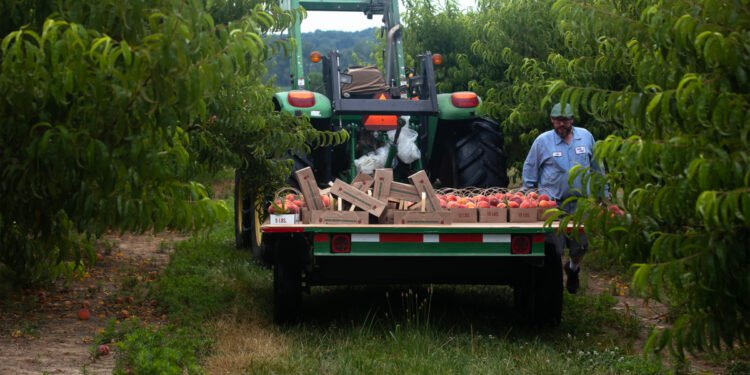Cardinal Farms owner Tim Alexander says this peach season has been especially strange—and difficult.
For one, only five of his 12 varieties produced any fruit, leaving this harvest as one of his smaller in recent memory. Alexander says he’s hoping to make 30% of what he does in a normal year, although it’s difficult to tell what’s normal anymore.
“I haven’t had a typical year in the last five or six years,” he says.
Alexander said the variety, Garnet Beauty, which is the first peach to ripen, usually at the end of June, was ready a full 10 days early on June 19.
The second variety, Redhaven, usually not ready until several days past Independence Day, were being picked on June 29.
He said that the variety of his peaches ripen in a certain order, so that when one variety finishes and there are no more left to pick, he knows the next will be ready soon.
“But this year it’s been very difficult to judge when things are going to be ready,” Alexander said.
Alexander stops short of blaming climate change. “Hard to say,” he says.
But he did point at the higher level of extreme weather—highs and lows, droughts and downpours—that have been making farming even more of a guessing game than ever, especially this year.
It started in December, Alexander said. Then, a weather shift from 65 degrees Fahrenheit to -4 in a matter of 36 hours did the first wave of damage.
“The trees themselves were dormant at the time,” Alexander said. “But they hadn’t had enough cold weather to really harden them off and it killed the vast majority of the fruit buds on the trees.”
Alexander said he wasn’t sure if that deep freeze had left any viable buds on the trees, but in late February, 80-degree days brought remaining buds out of dormancy. Trees started blooming in March. But then successive cold snaps wiped out those blooms, he said.
Later in March, a third flush of blooms arrived on his trees and that’s what produced his crop this year, he said.
“This is without a doubt the worst year I’ve had in the last decade,” Alexander said.
During early summer, the area was affected by six weeks of drought. And then in one weekend, close to 3 inches of rain fell. Alexander said that extreme weather is harsh on crops.
“Things like peaches will soak up that water very quickly and bust open,” he said. “And when the skin bursts open, it’s ruined and it’s no longer a marketable product.”
Another challenge are pests, particularly the brown marmorated stink bug, an invasive insect from Asia first coming to the U.S. in the 1990s, likely on a shipping container
“The stink bug has a hypodermic needle … and they stick that into a small, immature peach and suck out material from the peach,” Alexander said. “And then the peach grows around that wound and it’s a deformed peach. It’s no longer a marketable product.”
Alexander said a normal season runs into mid-September, lasting ten weeks. This year will probably be done by early August after five weeks, he said.
Alexander, who call himself a “peach nerd,” has been working in the orchard since he was 12 years old. Though he at one time was a corn and soybeans farmer, peaches have been his main source of income for the past 23 years, he said.
“Growing peaches kind of feeds my soul,” he said.
And so, despite the hardship, he’ll be back at it next year, like millions of farmers before him who’ve had a bad year.
“Farmers are pessimistic optimists,” he said. “They’ll tell you how bad it is and how bad they did this year. But by God, they’re going to do it again next year.”



















